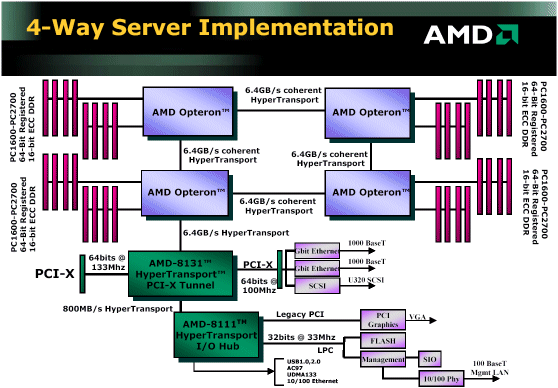Paul: Eric, I heard about your proposal, frankly, I was disappointed. "Core Duel"? What does that mean? We just lost a dual
core duel against AMD. Actually, we did not answer the duel, but AMD shamelessly crowned itself as the champ, even more ridiculously, the media applauded. The worst thing was that I couldn't say anything to refute the Frenchman. No need to remind people of that episode. Google it and everyone can see it.
Eric: Sorree sir, I meant "Core Duo", C-O-R-E D-U-O. Our dual die CPUs are like two singers in a duet, they share the bandwidth.
Paul: They do?
Eric: Yes. The two cores in our next gen CPU share a FSB, just like two singers share the air as a medium for sound waves.
Paul: That's good analogy indeed, some deep physics too, and "Core Duo" does have a ring to it.
Eric: Thank you, sir. I tried a lot of word combinations on an expensive grid computer and finally nailed it.
Paul: Did you use a Xeon cluster for that?
Eric: No, I didn't. I was afraid the cluster would cause a
power outage in our headquaters. I tried some 3rd party service...
Paul: I hope you didn't spend a fortune on it.
Eric: Well, in fact, it's kind of cheap. SUN is doing this $1 per CPU hour computing service with a whole bunch of Opterons, I used 10,000 CPU hours, the SUN folks were bad at accounting and only charged me $100 bucks.
Paul: Ha ha. That's sweet, no wonder those guys are not profitable..."Core Duo", hmm, it's new and refreshing indeed.
Eric: Yes. I believe it will get people's attentions, again.
Paul: What if we do quad core later. You will call it "Core Quadro"?
Eric: Exactly, you are so good...
Paul: Of course, I have been doing marketing for years.
Eric: We also need to change the INTEL logo.
Paul: What? That logo was created by Dr. Moore himself and has been with us for almost 40 years.
Eric: Forgive me. You may not believe this, but in Korea we do. I hired a Fengshui master to check out the AMD logo and INTEL's. The master said it looks like the arrow on the AMD logo shoots down the "e" on INTEL-- "e" could mean "emotions", "earnings" or even "existence"...
Paul: Fengshui? That's superstition.
Eric: Actually, it has scienctific foundation, it's like the Butterfly effect, you see, everyone of us looks at the logo with the fallen "e", that creates a mental effect and ....
Paul: I see where you are going, are you sure about this stuff?
Eric: Absolutely.
Paul: OK. Fine. How do we escape the arrow?
Eric: Let me show you ....
Paul: Not bad, not bad at all, this oval is like an impregnable fortress... What about "Intel Inside", we spent billions on this,
our lawyers threatened a lot of people who use the "inside" word, it's like we own this word in the English dictionary, and it worths 36 billion dollars -- which I hope I can put on our balance sheet... Why change it?
Eric: Same reason. The master said that "inside" renders a picture of confinement, and leads to contraction of our markets. We have to get rid of it. But if you insist on not changing it, it's ok, in any case, it is a 36 billion brand...
Paul: No, no, no. I am open minded. We need to try everything we can to change our situation--our current situation is bad... we are getting squeezed inside, by Opterons at the top and Semprons at the bottom, we need to break out.
Eric: I understand, there is a Chinese saying, "desperate man try desperate things". I suggest we change "Intel Inside" to "Leap Ahead".
Paul: Why not "leap forward"?
Eric: "Leap forward" is just going forward, we are always going forward, aren't we? Our
Paxville is 50% better then previous Xeons, but that's not good enough. Also, "leap forward" reminds people of the "great leap forward" by Chairman Mao.
Paul: What was that?
Eric: As neighbours, we know Chinese history pretty well. Chairman Mao created this "leap forward" program to catch up with UK in 3 years and surpass US in 10 years.
Paul: I see, I recall watching about it on history channel.
Eric: Since we are behind, we need to leap ahead.
Paul: I see, ahead, ahead of ...
Eric: AMD...
Paul: Good. Now we marketing has defined the job...
Eric: it's up to the engineering to execute it.
Paul: That 's our core advantage, marketing is job 1, and manufacturing is job 2...
Eric: ...Craig said manufacturing was job 1.
Paul: I switched the priorities around.
Eric: So, design is job 3.
Paul: Exactly. I couldn't help laughing when AMD promoted a chip designer to President and COO...
Eric: That's dumb, but the way they did it
attracted a lot of top geeks from IBM, SUN and DEC, they got titles equal to Corporate VP...
Paul: That's why we recently promoted some chip folks to senior VPs. Let me call them... what are their names?





